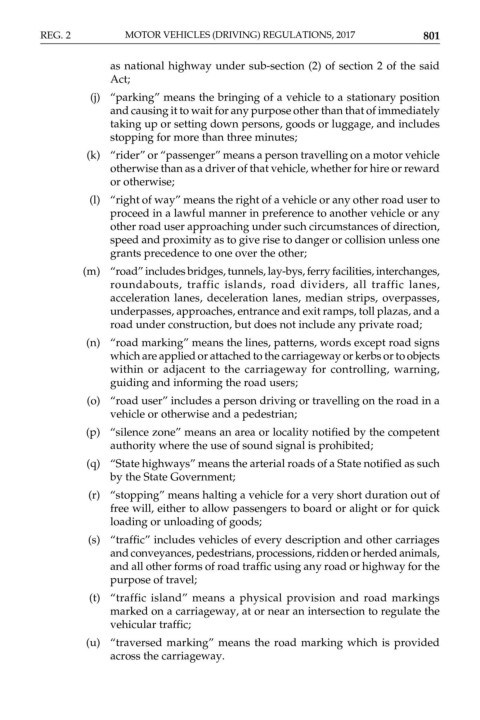Page 829 - The Central Motor Vehicles Rules, 1989
P. 829
REG. 2 MOTOR VEHICLES (DRIVING) REGULATIONS, 2017 801
as national highway under sub-section (2) of section 2 of the said
Act;
(j) “parking” means the bringing of a vehicle to a stationary position
and causing it to wait for any purpose other than that of immediately
taking up or setting down persons, goods or luggage, and includes
stopping for more than three minutes;
(k) “rider” or “passenger” means a person travelling on a motor vehicle
otherwise than as a driver of that vehicle, whether for hire or reward
or otherwise;
(l) “right of way” means the right of a vehicle or any other road user to
proceed in a lawful manner in preference to another vehicle or any
other road user approaching under such circumstances of direction,
speed and proximity as to give rise to danger or collision unless one
grants precedence to one over the other;
(m) “road” includes bridges, tunnels, lay-bys, ferry facilities, interchanges,
roundabouts, traffic islands, road dividers, all traffic lanes,
acceleration lanes, deceleration lanes, median strips, overpasses,
underpasses, approaches, entrance and exit ramps, toll plazas, and a
road under construction, but does not include any private road;
(n) “road marking” means the lines, patterns, words except road signs
which are applied or attached to the carriageway or kerbs or to objects
within or adjacent to the carriageway for controlling, warning,
guiding and informing the road users;
(o) “road user” includes a person driving or travelling on the road in a
vehicle or otherwise and a pedestrian;
(p) “silence zone” means an area or locality notified by the competent
authority where the use of sound signal is prohibited;
(q) “State highways” means the arterial roads of a State notified as such
by the State Government;
(r) “stopping” means halting a vehicle for a very short duration out of
free will, either to allow passengers to board or alight or for quick
loading or unloading of goods;
(s) “traffic” includes vehicles of every description and other carriages
and conveyances, pedestrians, processions, ridden or herded animals,
and all other forms of road traffic using any road or highway for the
purpose of travel;
(t) “traffic island” means a physical provision and road markings
marked on a carriageway, at or near an intersection to regulate the
vehicular traffic;
(u) “traversed marking” means the road marking which is provided
across the carriageway.

